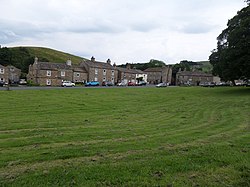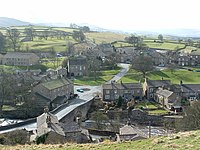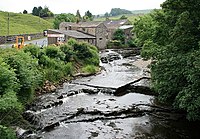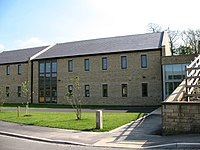Bainbridge
| Bainbridge | |
| Yorkshire North Riding | |
|---|---|
 Bainbridge | |
| Location | |
| Grid reference: | SD934904 |
| Location: | 54°18’33"N, 2°6’9"W |
| Data | |
| Population: | 480 (2011) |
| Post town: | Leyburn |
| Postcode: | DL8 |
| Local Government | |
| Council: | Richmondshire |
| Parliamentary constituency: |
Richmond (Yorks) |
Bainbridge is a village in the North Riding of Yorkshire, in Wensleydale on the south side of the River Ure. The village stands near the confluence of the short River Bain with the Ure.
The population of the civil parish as of the 2011 census was 480. The civil parish includes Raydale, and a large area of moorland south of the village. It also includes the hamlets of Worton and Cubeck to the east of the village.
History
The Romans were here: their name for the place was Virosidum and the remains of a Roman fort are located just east of Bainbridge, on the other side of the river, on Brough Hill, where various Roman remains have been found. These have been designated a Scheduled Ancient Monument.[1][2] Nearby is Cam High Road, which follows the line of a Roman Road.
At the time of the Norman invasion there was no village, and hence no entry in the Domesday Book. The site of the modern town was at that time covered in forest and known as 'The Forest of Bainbridge', alluding to the bridge crossing both the Bain and Ure at this location. The lands after the Norman invasion were in the hands of Count Alan of Brittany.[2][3]
Between 1146 and 1170 Conan IV, Duke of Brittany and Earl of Richmond, granted the wardship of the forest to the lords of Middleham. It was they who built the manor and village of Bainbridge. Towards the end of the twelfth century a dispute arose between the Abbot of Jervaulx and Ranulph, son of Robert Fitz Randolph, over the building of more houses in the village. Ranulph's argument was that the town existed before he became lord. Ralph Earl of Chester was requested to resolve the matter in 1229. Ranulph stated that "the town of Beyntbrigg belonged to his ancestors by service of keeping the forest, so that they might have abiding there 12 foresters, and that every forester should have there one dwelling-house and 9 acres of land." The lords of Middleham had not held the office of Forester since 1280, when Peter of Savoy, Earl of Richmond, had distributed land in the manor to tenants to hold. The manor was valued at more than a third of the revenue of the earldom at that time.[2][3]
Bainbridge followed the descent of the manor of Richmond till 1413, when Henry IV granted to Ralph Earl of Westmorland the manor, town and bailiwick of Bainbridge. The Neville family were also lords of Middleham at the time and followed its descent until 1628 when it was granted to the City of London. The City sold it in 1663 to eleven of the principal inhabitants, who held the manor in trust for the freeholders.[2][3]
The village's only pub, the Rose and Crown, is reputed to be one of Yorkshire's oldest having been in operation since 1445.
Geography
The village is on the A684 road, near the meeting of the River Bain with the River Ure. The River Bain is designated legally as a Main River, so at around two and a half miles long is reputed to be the shortest river in Britain.[4]
The village has an unusual hydroelectric power station driven by the River Bain, in the form of an Archimedes screw, or rather a reversed Archimedes screw.
The civil parish includes Raydale (the hamlets of Countersett, Marsett, Stalling Busk), the valley to the south of the village, and a large area of moorland around Raydale. There are several streams that feed the lake at Semer Water, which in turn is the start of the River Bain. Cragdale Water drains the land on Cragdale Moor, whilst Raydale Beck flows through a substantial wooded area and Bardale Beck drains the marshy area known as Fleet Moss. The highest point in the parish is the peak on Cragdale Moor between Middle Tongue Tarn and Hunters Hole at 2,110 feet.
Community and culture
Bainbridge is served by a local inn (the Rose and Crown), a small village shop with post office and a local butcher. An equestrian centre offering riding lessons and local trekking can be found a short distance away at Gill Edge. There are a number of tea shop facilities for tourists.
Bainbridge C of E Primary School provides primary education for the Parish.[5]
The Yorkshire Dales National Park Authority has its headquarters in the village and employs around 120 staff.
A local custom in Bainbridge is the sounding of an ancient horn which was once used to guide foresters and travellers safely to the village from the surrounding Wensleydale forests. The horn is still located at the Rose and Crown public house and is sounded every night at 10 pm from the Feast of Holy Rood (27 September) to Shrove Tuesday.[6]
Churches
The parish had Wesleyan and Congregational chapels, built in 1836 and 1864 respectively.[2][3] The former is still in use as a Methodist chapel; the latter is now a house.
The Quaker Society of Friends has been present in Bainbridge since the 1600s. The present Bainbridge meeting house was built in 1836 to replace a cottage bought in 1668. It is a Grade II listed building.[2][7] The burial ground has been in use since 1672.
Outside links
| ("Wikimedia Commons" has material about Bainbridge) |
References
- ↑ National Heritage List 1017920: Bainbridge Roman fort and annexe
- ↑ 2.0 2.1 2.2 2.3 2.4 2.5 History
- ↑ 3.0 3.1 3.2 3.3 Bulmer's Topography, History and Directory (Private and Commercial) of North Yorkshire 1890. S&N Publishing. 1890. p. 338. ISBN 1-86150-299-0.
- ↑ "Main Rivers". Flood Risk Assessment and Other Guidance. Environment Agency. http://www.environment-agency.gov.uk/research/planning/93498.aspx. Retrieved 3 January 2010.
- ↑ "Primary School". Archived from the original on 7 August 2013. https://web.archive.org/web/20130807151752/http://bainbridgeschool.co.uk/welcome.asp. Retrieved 27 March 2013.
- ↑ "Bainbridge, Upper Wensleydale, Yorkshire Dales - accoodation, local attractions...". The Business Association (Wensleydale) Ltd. http://www.wensleydale.org/Wensleydale/OurVillages/Bainbridge.aspx. Retrieved 13 August 2013.
- ↑ Friends Meeting House, Bainbridge - British Listed Buildings


